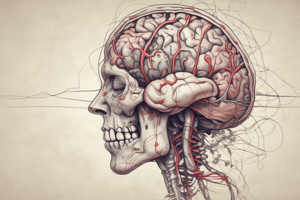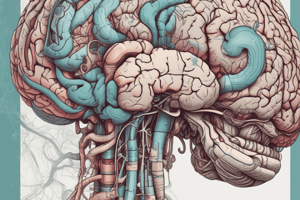Podcast
Questions and Answers
What is the term for the largest part of the brain responsible for higher brain functions?
What is the term for the largest part of the brain responsible for higher brain functions?
- Brainstem
- Diencephalon
- Cerebellum
- Cerebrum (correct)
Which part of the brain is associated with balance and coordination?
Which part of the brain is associated with balance and coordination?
- Frontal Lobe
- Brainstem
- Cerebellum (correct)
- Cerebrum
What is the term for the region of the brain involved in relaying sensory information?
What is the term for the region of the brain involved in relaying sensory information?
Thalamus
What is the function of the hypothalamus?
What is the function of the hypothalamus?
Which structure connects the left and right cerebral hemispheres?
Which structure connects the left and right cerebral hemispheres?
Which lobe of the brain is primarily responsible for processing visual information?
Which lobe of the brain is primarily responsible for processing visual information?
What is the primary function of the brainstem?
What is the primary function of the brainstem?
The ______ is a gland that secretes hormones controlling various bodily functions.
The ______ is a gland that secretes hormones controlling various bodily functions.
What structures are involved in the peripheral nervous system?
What structures are involved in the peripheral nervous system?
Which layer of the meninges is the outermost layer?
Which layer of the meninges is the outermost layer?
Flashcards are hidden until you start studying
Study Notes
Brain Anatomy Terms
-
Cerebrum: Largest part of the brain, responsible for higher brain functions such as thought, action, and emotion.
-
Cerebellum: Located under the cerebrum, it coordinates voluntary movements, balance, and motor control.
-
Diencephalon: Contains structures such as the thalamus and hypothalamus, involved in processing sensory information and regulating homeostasis.
-
Brainstem: Connects the brain to the spinal cord, controlling automatic functions like breathing, heart rate, and blood pressure.
-
Frontal Lobe: Associated with reasoning, planning, problem-solving, and emotional regulation. Located at the front of the brain.
-
Occipital Lobe: Located at the back of the brain, primarily responsible for processing visual information.
-
Parietal Lobe: Processes sensory information such as touch, temperature, and pain. Positioned at the top of the brain.
-
Temporal Lobe: Involved in processing auditory information and is crucial for memory and emotion. Located on the sides of the brain.
Neuroanatomy Structures
-
Hypothalamus: Regulates vital bodily functions including temperature, hunger, and circadian rhythms.
-
Thalamus: Acts as a relay station for sensory information (except smell) to the cerebral cortex.
-
Epithalamus: Includes the pineal gland, which secretes melatonin and regulates circadian rhythms.
-
Midbrain: Plays a key role in vision, hearing, motor control, sleep/wake cycles, and temperature regulation.
-
Pons: Connects different parts of the brain, relaying signals between the cerebrum and cerebellum, influencing breathing and sleep.
-
Medulla Oblongata: Controls involuntary functions such as heart rate and blood pressure, located at the base of the brainstem.
Glandular Structures
-
Pituitary Gland: Often referred to as the "master gland," it regulates other endocrine glands and various bodily functions.
-
Pineal Body: Produces melatonin, regulating sleep-wake cycles and biological rhythms.
-
Mammillary Body: Involved in memory processing and is part of the limbic system.
Visual Pathways
- Optic Chiasma: The structure where the optic nerves partially cross, allowing visual information from both eyes to be processed.
Neuronal Types
-
Bipolar Neuron: A neuron with two extensions; often found in sensory pathways, such as vision and smell.
-
Unipolar Neuron: A neuron with a single process extending from the cell body, primarily found in sensory neurons of the PNS.
-
Multipolar Neuron: Most common type of neuron, with one long axon and multiple dendrites, facilitating communication within the CNS.
Neuron Components
-
Dendrite: Branching extensions of neurons that receive signals from other neurons.
-
Axon: Long projection of a neuron that transmits electrical impulses away from the cell body.
-
Cell Body: Contains the nucleus and organelles of the neuron, crucial for cell function.
-
Nodes of Ranvier: Gaps in the myelin sheath that facilitate the rapid transmission of nerve impulses.
-
Schwann Cell: Glial cells in the PNS that produce the myelin sheath around peripheral nerve fibers.
-
Synaptic Knob: The end of an axon that releases neurotransmitters to communicate with other neurons.
Nervous System Components
-
Sense Receptor: Specialized cells that detect environmental stimuli and convert them into neural signals.
-
Sensory Neuron: Carries information from sensory receptors to the central nervous system (CNS).
-
Interneuron: Connects sensory and motor neurons within the CNS, processing information and reflexes.
-
Motor Neuron: Transmits signals from the CNS to effectors (muscles or glands).
-
Effector: Muscle or gland that responds to nervous stimulation, resulting in action or secretion.
Nervous Systems
-
CNS (Central Nervous System): Comprises the brain and spinal cord, responsible for processing and integrating information.
-
PNS (Peripheral Nervous System): Consists of all neurons outside the CNS, connecting the brain and spinal cord to the body.
Meningeal Layers
-
Dura Mater: The outermost and toughest layer of the meninges, protecting the brain and spinal cord.
-
Arachnoid Mater: The middle layer of the meninges, serving as a barrier and contains cerebrospinal fluid.
-
Pia Mater: The innermost layer of the meninges, closely adheres to the brain, providing additional protection and nourishment.
Studying That Suits You
Use AI to generate personalized quizzes and flashcards to suit your learning preferences.



